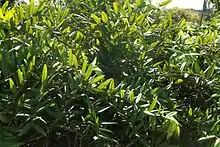Myrciaria glomerata
Myrciaria glomerata, commonly known as cabeludinha-vermelha (red cabeludinha) or cabeluda-escarlate (scarlet cabeluda),[3] is a species of plant in the family Myrtaceae. It is an evergreen shrub or small tree, endemic to the north and east of Brazil.[4] Myrciaria glomerata has historically been used to incorrectly describe Myrciaria glazioviana.[3]
| Myrciaria glomerata | |
|---|---|
 | |
| Myrciaria glomerata | |
| Scientific classification | |
| Kingdom: | Plantae |
| Clade: | Tracheophytes |
| Clade: | Angiosperms |
| Clade: | Eudicots |
| Clade: | Rosids |
| Order: | Myrtales |
| Family: | Myrtaceae |
| Genus: | Myrciaria |
| Species: | M. glomerata |
| Binomial name | |
| Myrciaria glomerata | |
| Synonyms[2] | |
| |
Description
Myrciaria glomerata grows up to 8 metres tall, and produces edible red fruits around 20mm in diameter.[5] The fruit pulp is slightly yellow and rich in Vitamin C.[6]
The leaves of Myrciaria glomerata are simple, opposite, lanceolate, pinnate and chartaceous. They are between 3 and 4cm wide, and between 9 and 11cm long. The top of the leaves are bright dark green, and the underside is light green and very hairy. The hairyness of Myrciaria glomerata is helpful for the identification of this species.[7]
References
- "Myrciaria glomerata O.Berg". gbif.org. Retrieved January 16, 2021.
- "Myrciaria glomerata O.Berg". The Plant List. Retrieved January 2, 2021.
- "Frutíferas, Myrciaria glomerata / cabeludinha-vermelha ou cabeluda-escarlate". e-jardim.com (in Portuguese). Retrieved January 2, 2021.
- "Myrciaria glomerata O.Berg". Plants of the World Online. Retrieved January 2, 2021.
- "Myrciaria glomerata". Useful Tropical Plants. Retrieved January 2, 2021.
- Soubihe Sobrinho, J.; Pelegrino, D.; Gurgel, J. T. A; Leme Junior, J.; Malavolta, E. (1955). "Vitamina C em "Cabeludinha" (Myrciaria glomerata Berg)". Bragantia. 14 (19): 193–201.
- Veiga Pacheco-Silva, Nemes; Maria Donato, Ana (2016). "Morpho-anatomy of the leaf of Myrciaria glomerata". Revista Brasileira de Farmacognosia. 26: 275–280.
